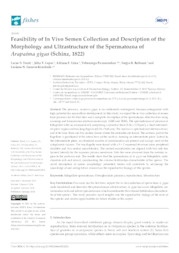Feasibility of In Vivo semen collection and description of the morphology and ultrastructure of the spermatozoa of Arapaima gigas (Schinz, 1822).
Feasibility of In Vivo semen collection and description of the morphology and ultrastructure of the spermatozoa of Arapaima gigas (Schinz, 1822).
Author(s): TORATI, L. S.; LOPES, J. T.; LIMA, A. F.; PUVANENDRAN, V.; BATLOUNI, S. R.; KIRSCHNIK, L. N. G.
Summary: The pirarucu, Arapaima gigas, is an emblematic endangered Amazon osteoglossid with high potential for aquaculture development. In this study, we report the in vivo collection of semen from pirarucu for the first-time and a complete description of the spermatozoa ultrastructure using scanning and transmission electron microscopy (SEM and TEM). The spermatozoon of pirarucu is biflagellate with no acrosomal cell, comprising a spherical head (8.26 ± 2.19 ?m2), a short intermediate piece region and two long flagella (68.34 ± 5.69 ?m). The nucleus is spherical and electron-dense, and at its base, there are two nuclear fossae where the centrioles are found. The anterior part of the flagellum is positioned at the lateral base of the nucleus, forming an intermediate piece. Lateral to the intermediate piece, an abundant number of mitochondria are present and occupy most of the cytoplasmic volume. The two flagella were found with a 9 + 2 axonemal structure (nine peripheral doublets and two central microtubules). The central microtubules are aligned with two side fins formed laterally by the axoneme plasma membrane. Side fins were observed from the anterior region to the posterior end. The results show that the spermatozoa of A. gigas are biflagellate, mitochondria-rich and robust, corroborating the external fertilization characteristic of the species. The novel description of sperm morphology presented herein will contribute to advancing the knowledge of and aiding future research on the reproductive biology of this species.
Publication year: 2024
Types of publication: Journal article
Observation
Some of Embrapa's publications are published as ePub files. To read them, use or download one of the following free software options to your computer or mobile device. Android: Google Play Books; IOS: iBooks; Windows and Linux: Calibre.
Access other publications
Access the Agricultural Research Database (BDPA) to consult Embrapa's full library collection and records.
Visit Embrapa Bookstore to purchase books and other publications sold by Embrapa.

